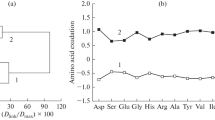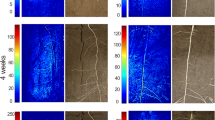Summary
The distribution of enzymatic activity between roots of barley and the rhizoplane has been determined for three enzymes, namely phosphatase, urease, and invertase. Phosphatase and invertase activity of the root zone can be attributed in great part to enzymes of the root itself, while urease activity is entirely a function of rhizoplane organisms. In contrast, appreciable amounts of proteinase, esterase, amidase and asparaginase activities were not found in the roots and the rhizoplane of barley during the same short times of observations.
The kinetics of phosphatase activity of sterile, 6-day barley roots have been studied in some detail. The pH optimum is pH 5.3; the temperature optimum is at 38°C. Magnesium ion in concentrations of 0.2×10−3 to 1×10−3 moles per ml has a stimulatory effect on sterile root phosphatase activity and quaternary ammonium compounds in low concentration induce a doubling of root phosphatase activity. Root phosphatase activity is found in the root cap and on the epidermis.
Similar content being viewed by others
References
Birt, L. M. and Hird, F. J. R., The uptake of amino acids by carrot slices. Biochem. J.64, 305–311 (1956).
Brown, R. and Robinson, E., Cellular differentiation and the development of enzyme proteins in plants.In: E. G. Butler, Biological Specificity and Growth, pp. 93–118. Princeton Univ. Press, Princeton (1955).
Burstrom, H., Studies on the carbohydrate nutrition of roots. Ann. Agr. Coll. Sweden9, 264–285 (1941).
Clark, F. E., Soil micro-organisms and plant roots. Advances Agron.1, 242–288 (1949).
Conway, E. J. and Byrne, A., An absorption apparatus for the microdetermination of certain volatile substances. I. The microdetermination of ammonia. Biochem. J.27, 419–429 (1933).
Dawson, R. M. C. and Bangham, A. D., The activation of surface films of lecithin by amphipathic molecules. Biochem. J.72, 493–496 (1959).
Flaig, W. and Kaul, R., Über die Einwerkung von Ribonucleinsaüre auf das Pflanzenwachstum. Z. Pflanzenernähr. Düng. Bodenk.72, 103–113 (1956).
Ghosh, B. P. and Burris, R. H., Utilization of nitrogenous compounds by plants. Soil Sci.70, 187–203 (1950).
Gerretsen, F. C., The influence of micro-organisms on the phosphate intake by the plant. Plant and Soil1, 51–85 (1948).
Hayashi, T. and Takijima, Y., Utilization of soil organic phosphorus by crop plants. VI. J. Sci. Soil Manure Japan27, 15–18 (1956).
Jensen, W. A., The cytochemical localization of acid phosphatase in root tip cells. Am. J. Bot.43, 50–54 (1956).
Kenten, R. H., Latent phenolase in extracts of broad bean leaves. II. Activation by anionic wetting agents. Biochem. J.68, 244–251 (1958).
Krasilnikov, N. A., Importance of soil micro-organisms in plant nutrition. Mikrobiologiya26, 659–672 (1959).
Kuff E. L. and Dalton, A. J., Biochemical studies of isolated Golgi membranes.In: Subcellular Particles, pp. 114–127. Y. Hayashi Ed. Ronald Press Co., New York, (1959).
Kuprevich, V. F., The cell surface enzymes of the higher autotrophic plant roots. Doklady Akad. Nauk. USSR68, 953 (1949).
Lowry, O. H., Rosebrough, N. J., Farr, A. L., and Randall, R. J., Protein measurement with the Folin-phenol reagent. J. Biol. Chem.193, 265–275 (1951).
McGregor, S. M. and Street, H. E., Carbohydrate nutrition of tomato roots. IV. The nature and distribution of seed phosphatases. Ann. Bot.17, 385–394 (1953).
McLaren, A. D., Jensen, W., and Jacobson, L., Adsorption of enzymes and other proteins by barley roots. Plant Physiol.35, 549 (1960).
Majumder, S. K. and Dunn, S., Use of organic phosphate in nutrient culture. Plant and Soil10, 266–270 (1959).
Martin, J. B. and Doty, D. M., Determination of inorganic phosphate. Anal. Chem.21, 965–967 (1949).
Mollenhauer, H. H., Whaley, W. G. and Leech, J. H., A function of the Golgi apparatus in outer rootcap cells. J. Ultrastructure Research,5, 193–200 (1961).
Palade, G. E., Intracellular distribution of acid phosphatase in rat liver cells. Arch. Biochem. Biophys.30, 144–158 (1950)
Ratner, E. I. and Samoilova, S. A., Extracellular phosphatase activity of roots. Fiziol. Rastinii2, 30–41 (1955).
Ratner, E. I. and Samoilova, S. A., Uptake of organic compounds of orthophosphoric acid by plants in connection with extracellular phosphatase activity of roots. Fiziol. Rasteniî Akad. Nauk. S.S.S.R.2, 518–528 (1955).
Ratner, E. I. and Samoilova, S. A., Assimilation of nucleic acids by plants and extracellular phosphatase activity of roots. Fiziol. Rasteniî Akad. Nauk. S.S.S.R.5, 209 (1958).
Rogers, H. T., Pearson, R. W., and Pierre, W. H., Absorption of organic phosphorus by corn and tomato plants and the mineralizing action of exo-enzyme systems of growing roots. Soil Sci. Soc. Am. Proc.5, 285–291 (1940).
Sigma Chemical Co., St. Louis, Mo. Technical Bulletin No. 104, Sept. 1958.
Starkey, R. L., Interrelations between micro-organisms and plant roots in the rhizosphere. Bacterol. Rev.22, 154–172 (1958).
Steinberg, R. A., Growth responses to organic compounds by tobacco seedlings in asceptic culture. J. Agr. Research75, 81–92 (1947).
Szember, A., Influence on plant growth of the breakdown of organic phosphorus compounds by micro-organisms. Plant and Soil8, 146–158 (1960).
Werbin, H. Ph.D. Dissertation. Polytechnic Institute of Brooklyn (1950).
Worthington Biochem. Co., New Jersey. Glucostat, a quantitative glucose reagent.
Author information
Authors and Affiliations
Rights and permissions
About this article
Cite this article
Estermann, E.F., McLaren, A.D. Contribution of rhizoplane organisms to the total capacity of plants to utilize organic nutrients. Plant Soil 15, 243–260 (1961). https://doi.org/10.1007/BF01400458
Received:
Issue Date:
DOI: https://doi.org/10.1007/BF01400458




